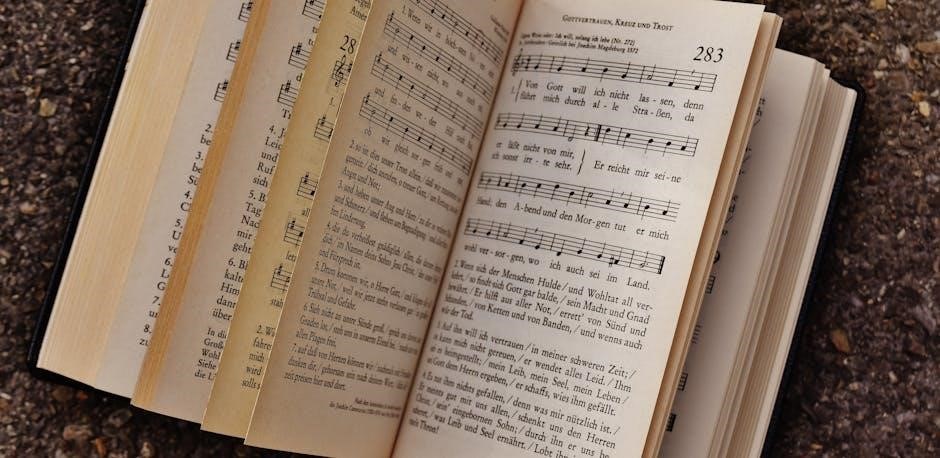Sweeney Todd: The Demon Barber of Fleet Street is a Tony Award-winning musical thriller with a haunting score by Stephen Sondheim, blending dark themes and complex melodies, making it a timeless classic in musical theater history․
Overview of Sweeney Todd: The Demon Barber of Fleet Street
Sweeney Todd: The Demon Barber of Fleet Street is a Tony Award-winning musical thriller with a dark and captivating storyline․ It tells the tale of Benjamin Barker, a barber unjustly imprisoned, who returns to London as Sweeney Todd, seeking revenge․ Alongside Mrs․ Lovett, his accomplice, Todd devises a sinister plan involving a razor and a pie shop․ The musical, written by Hugh Wheeler with music and lyrics by Stephen Sondheim, masterfully blends horror, comedy, and tragedy․ Its intricate plot, combined with Sondheim’s haunting and complex score, has made it a classic in musical theater, exploring themes of vengeance, morality, and the human condition․
Historical Background and Inspiration for the Musical
Sweeney Todd: The Demon Barber of Fleet Street draws inspiration from 19th-century urban legends and penny dreadfuls, particularly The String of Pearls, which introduced the character of Sweeney Todd․ The story revolves around a vengeful barber and his accomplice, Mrs․ Lovett, whose dark partnership drives the plot․ Stephen Sondheim and Hugh Wheeler adapted this macabre tale into a musical thriller, blending historical elements with psychological complexity․ The original story’s Victorian setting and themes of revenge and morality influenced the musical’s tone and score․ The adaptation also reflects Sondheim’s fascination with the darker aspects of human nature, transforming the folklore into a masterpiece of modern musical theater․
The Musical Composition and Score
Stephen Sondheim’s masterful score for Sweeney Todd combines dark, intricate melodies with haunting harmonies, creating a captivating orchestration that mirrors the musical’s sinister and emotional depth․
Stephen Sondheim’s Role in Creating the Score
Stephen Sondheim was the mastermind behind the Sweeney Todd score, crafting a complex and emotionally charged musical landscape․ His work on both the music and lyrics ensured a cohesive narrative, blending dark humor with intense drama․ Sondheim’s innovative use of leitmotifs and harmonic complexity elevated the story, making the score a landmark in musical theater․ His meticulous attention to detail and ability to evoke psychological depth through melody set a new standard for Broadway compositions, solidifying Sweeney Todd as a classic․
Key Musical Themes and Motifs in Sweeney Todd
The score of Sweeney Todd features a rich tapestry of musical themes and motifs that enhance the story’s dark, gothic atmosphere․ The recurring “Ballad of Sweeney Todd” serves as a haunting refrain, while motifs like “The Barber and His Wife” and “Johanna” evoke emotional depth․ Sondheim’s use of leitmotifs ties characters to specific musical ideas, creating a sense of continuity․ Themes of revenge, obsession, and mortality are underscored by unsettling harmonies and rhythmic intensity․ The interplay between dark, brooding melodies and moments of macabre humor showcases Sondheim’s masterful craftsmanship, making the score a defining element of the musical’s enduring legacy․
The Orchestra and Instrumentation in the Score
The score of Sweeney Todd is written for a full orchestra, with instrumentation that emphasizes dark, gothic tones․ Strings provide lush, eerie textures, while woodwinds and brass add sharp, unsettling accents․ Percussion is used sparingly but effectively to heighten tension․ The piano often underscores key moments, adding a sense of intimacy and foreboding․ Sondheim’s orchestration is meticulously crafted to reflect the musical’s themes of revenge and madness․ The interplay between instruments creates a dramatic, immersive experience, with each section contributing to the overall macabre atmosphere․ This intricate instrumentation is a hallmark of the score, making it a masterpiece of modern musical theater composition․

Themes and Elements in the Score
The score of Sweeney Todd masterfully incorporates dark, gothic elements, psychological depth, and recurring leitmotifs, creating a haunting and emotionally layered soundscape that underscores the musical’s themes of revenge and madness․
Dark and Gothic Elements in the Music
The score of Sweeney Todd is deeply infused with dark and gothic elements, reflecting the macabre narrative․ Stephen Sondheim’s use of minor keys, dissonant harmonies, and unsettling rhythms creates a haunting atmosphere․ The music often features motifs associated with death, revenge, and madness, such as the ominous barber shop theme and the chilling “Swing Your Razor” melody․ These elements not only enhance the story’s eerie tone but also evoke a sense of dread and tension, immersing the audience in the grim world of Fleet Street․ The gothic undertones in the score are integral to the musical’s thrilling and unsettling experience․
Psychological Depth Through Musical Composition
Stephen Sondheim’s score for Sweeney Todd masterfully explores the psychological complexity of its characters through music․ The melodies and harmonies mirror the characters’ inner turmoil, with motifs that evolve as their psyches unravel․ For instance, Sweeney Todd’s themes are marked by brooding intensity and vengeful undertones, while Mrs․ Lovett’s music often carries a darkly comedic, almost maniacal quality․ The score delves into the duality of human nature, blending moments of tenderness with sinister undertones․ This integration of psychological depth into the composition creates a multi-layered narrative, allowing the audience to connect deeply with the characters’ motivations and emotional journeys, enhancing the overall dramatic impact of the musical․
The Use of Leitmotifs in Sweeney Todd
Stephen Sondheim’s score for Sweeney Todd employs leitmotifs to represent characters, themes, and emotional states, creating a rich musical narrative․ These recurring motifs are woven throughout the score, evolving as the story progresses․ For instance, Sweeney Todd’s theme is dark and menacing, reflecting his obsession with revenge, while Mrs․ Lovett’s motifs often carry a playful yet sinister tone․ Leitmotifs for Johanna and Anthony evoke innocence and romance, contrasting with the darker elements․ This technique enhances the psychological depth and thematic coherence, allowing the audience to subconsciously connect with the characters’ journeys․ Sondheim’s masterful use of leitmotifs elevates the musical’s dramatic impact and emotional resonance․

Sheet Music and PDF Availability
Sweeney Todd sheet music and PDFs are widely available online, offering vocal, instrumental, and piano arrangements for enthusiasts and performers, ensuring accessibility to Sondheim’s iconic score․
Downloading Sweeney Todd Sheet Music for Free
Downloading Sweeney Todd sheet music for free is convenient, with numerous online platforms offering PDF and MIDI files of the iconic score․ Websites provide arrangements for piano, guitar, and other instruments, allowing enthusiasts to access Sondheim’s compositions easily․ Many platforms offer free downloads of songs like “Poor Thing” and “My Friends,” making it accessible for both personal enjoyment and performance․ However, users should verify the legality and quality of these downloads to ensure they are obtaining authentic and rights-compliant materials․ This accessibility has made Sweeney Todd’s score a favorite among musicians and theater enthusiasts worldwide, fostering its enduring popularity and creative reinterpretation․
Popular Platforms for Sweeney Todd PDF Downloads
Several platforms offer convenient access to Sweeney Todd sheet music in PDF format, catering to both enthusiasts and performers․ Websites like Musicnotes and SheetMusicPlus provide high-quality arrangements of Stephen Sondheim’s compositions, including songs like “Poor Thing” and “My Friends․” Additionally, free platforms such as MuseScore and PDFMiner allow users to download and print Sweeney Todd scores for personal use․ These resources enable musicians to explore and perform the iconic musical thriller’s score with ease․ However, users should always ensure they are accessing materials from legitimate sources to avoid copyright infringement and support the creators of this timeless work․
Legal Considerations for Using Sweeney Todd Sheet Music
Using Sweeney Todd sheet music requires adherence to copyright laws․ The score, composed by Stephen Sondheim, is protected under intellectual property rights, meaning unauthorized distribution or performance without proper licensing is illegal․ Platforms offering free PDF downloads may infringe on these rights, potentially leading to legal consequences․ To ensure compliance, users should obtain sheet music from authorized sources like Musicnotes or SheetMusicPlus, which provide licensed materials․ Additionally, public performances of the musical require permits from the copyright holders, typically managed through organizations like Music Theatre International․ Respecting these legal guidelines helps support the creators and ensures the continued availability of this iconic work for future generations․

Analysis of the Score
Stephen Sondheim’s score for Sweeney Todd is a masterpiece of musical theater, combining dark, gothic themes with intricate orchestration․ Its complex harmonies and recurring motifs create a haunting atmosphere that complements the story’s psychological depth․
Structural Analysis of the Musical Score
The score of Sweeney Todd is renowned for its intricate structure, blending operatic grandeur with musical theater conventions․ Stephen Sondheim’s composition features recurring motifs, such as the ominous “Ballad of Sweeney Todd,” which weaves throughout the narrative, reinforcing themes of vengeance and madness․ The music is divided into acts, with each song advancing the plot or deepening character psychology․ Harmonically rich and melodically complex, the score juxtaposes dark, gothic elements with moments of black humor and emotional depth․ Sondheim’s use of leitmotifs creates a cohesive yet haunting soundscape, while the orchestration—often featuring heavy brass and percussion—amplifies the macabre atmosphere․ This structural brilliance makes the score a cornerstone of modern musical theater․
Vocal and Instrumental Arrangements in the Score
The vocal and instrumental arrangements in Sweeney Todd are masterfully crafted to enhance the musical’s dark, gothic atmosphere․ Stephen Sondheim’s score features complex vocal harmonies, with characters like Sweeney Todd and Mrs․ Lovett delivering powerful, emotive performances․ The orchestration is rich and layered, often employing a full ensemble to create a sense of grandeur and tension․ Brass and percussion dominate, adding to the eerie and suspenseful tone, while strings provide emotional depth․ The arrangements are meticulously balanced, ensuring that both vocals and instruments are prominent without overpowering each other; This blend of intricate vocal work and dynamic instrumentation underscores the musical’s psychological complexity and dramatic intensity, making the score a masterpiece of modern theater music․
Harmonic and Melodic Complexity in Sweeney Todd
Stephen Sondheim’s score for Sweeney Todd is renowned for its harmonic and melodic sophistication, creating a rich, immersive experience․ The music features intricate chord progressions and dissonant harmonies that evoke the dark, gothic atmosphere of the story․ Melodies are often reprised in varying forms, adding depth and thematic continuity․ Sondheim’s use of motifs, such as the ominous “Ballad of Sweeney Todd,” underscores the narrative’s tension and psychological complexity․ The interplay between melody and harmony heightens emotional intensity, making the score both challenging for performers and deeply rewarding for audiences․ This complexity is a hallmark of Sondheim’s genius, ensuring the musical remains a masterpiece of modern theater․

Performance and Interpretation
Emma Thompson’s portrayal of Mrs․ Lovett in the New York Philharmonic’s production highlighted the score’s vibrancy, while various stagings have showcased the music’s adaptability and emotional depth, challenging performers to capture its psychological intensity and melodic complexity effectively․
Famous Performances and Interpretations of Sweeney Todd
The New York Philharmonic’s staging of Sweeney Todd featured Emma Thompson as Mrs․ Lovett, delivering a captivating performance that showcased the score’s symphonic richness․ Len Cariou and Angela Lansbury’s iconic portrayals in the original Broadway production set a high standard, blending vocal prowess with dramatic intensity․ The musical’s revival productions have also highlighted the versatility of Sondheim’s score, with directors and actors interpreting the dark narrative in innovative ways․ Notably, the 2023 revival emphasized the grandeur of the orchestration, allowing the music to resonate powerfully with audiences․ These performances underscore the timeless appeal of Sweeney Todd and its ability to captivate through both music and storytelling․
Challenges in Performing the Sweeney Todd Score
Performing the Sweeney Todd score presents significant challenges due to its complex musicality and dark thematic elements․ The intricate harmonies, rapid tempo changes, and demanding vocal ranges require exceptional skill from both singers and instrumentalists․ The orchestration, often written for a full ensemble, poses logistical challenges for smaller productions aiming to replicate the score’s grandeur․ Additionally, the psychological depth of the characters demands intense dramatic interpretation, making it difficult for performers to balance vocal precision with emotional authenticity․ The score’s gothic and unsettling tone further necessitates precise directorial choices to maintain the eerie atmosphere, adding another layer of complexity to its execution․
Directorial Choices and Their Impact on the Score
Directorial decisions significantly shape the interpretation and presentation of the Sweeney Todd score, influencing its emotional resonance and storytelling․ Choices in staging, lighting, and pacing can enhance or alter the musical’s dark, gothic atmosphere․ For instance, a minimalist set might emphasize the psychological complexity of the characters, while a grand, detailed backdrop could heighten the opera-like scale of the narrative․ Additionally, directorial interpretations of the characters’ relationships, such as the dynamic between Sweeney Todd and Mrs․ Lovett, can shift the audience’s perception of the score’s motifs and themes․ These creative decisions ultimately determine how the score is experienced, making each production unique and thought-provoking․

Cultural Impact and Legacy
Sweeney Todd has become a classic, influencing modern musical theater with its dark themes and complex score, leaving a lasting legacy in both critical acclaim and popular culture․
The Enduring Popularity of Sweeney Todd’s Score
Stephen Sondheim’s score for Sweeney Todd remains a masterclass in musical storytelling, blending dark humor, emotional depth, and complex melodies․ Its enduring popularity stems from its ability to evoke both horror and pathos, creating a haunting yet captivating experience․ The score’s intricate orchestration and recurring motifs, such as the ominous “Ballad of Sweeney Todd,” have become iconic in musical theater․ Its influence is evident in modern adaptations and revivals, showcasing its timeless appeal․ Fans and musicians alike continue to seek out Sweeney Todd sheet music and PDFs, further cementing its legacy as a cornerstone of the genre․
Influence on Modern Musical Theater
Sweeney Todd has profoundly shaped modern musical theater through its innovative score and dark narrative․ Stephen Sondheim’s complex harmonies and layered storytelling have inspired countless composers, pushing the boundaries of musical expression․ The integration of leitmotifs and psychological depth in its music has set a new standard for dramatic composition․ Many contemporary shows, from Phantom of the Opera to Hamilton, reflect its influence, adopting similar techniques to convey emotional complexity․ The availability of Sweeney Todd sheet music and PDFs has further spread its impact, allowing new generations to study and perform its iconic pieces, ensuring its enduring influence on the evolution of musical theater․
Critical Reception of the Score Over the Years
Sweeney Todd’s score has received widespread critical acclaim for its complexity and emotional depth․ Stephen Sondheim’s masterful composition, with its dark, gothic undertones, has been praised for its ability to evoke both terror and pathos․ Critics have highlighted the score’s innovative use of leitmotifs and its seamless integration with the musical’s themes of revenge and madness․ While some initially found the score challenging due to its dissonant harmonies, it has since been recognized as a masterpiece of modern musical theater․ Over the years, the score has been celebrated for its influence on the genre, with many regarding it as a landmark work in American musical theater․ Its enduring popularity continues to inspire new interpretations and performances․

Resources for Further Study
Explore Stephen Sondheim’s iconic score through PDF downloads and sheet music available on platforms like Musicnotes and Scribd․ Discover books analyzing the musical’s composition and attend workshops dedicated to its orchestration for deeper insight into its genius․
Recommended Websites for Sweeney Todd Score Downloads
For enthusiasts seeking Sweeney Todd sheet music, websites like Musicnotes and Scribd offer high-quality PDF downloads of the score․ These platforms provide access to piano, vocal, and instrumental arrangements, ensuring a comprehensive musical experience․ Additionally, sites like SheetMusicPlus and IMSLP host a variety of pieces from the musical, including iconic songs such as “Poor Thing” and “My Friends․” Users can also explore forums and communities dedicated to musical theater for shared resources․ Always ensure downloads are from trusted sources to avoid legal or quality issues․ These websites are invaluable for musicians, educators, and fans alike, offering a wealth of material to explore and perform․
Books and Articles About the Musical Score
Several books and articles delve into the complexities and brilliance of Stephen Sondheim’s score for Sweeney Todd․ Titles like Sondheim & Lapine’s Into the Woods and Sweeney Todd: The Demon Barber of Fleet Street offer in-depth analyses of the musical’s composition and themes․ Academic journals such as The Musical Quarterly and Studies in Musical Theatre feature essays exploring the score’s harmonic intricacies and psychological depth․ Additionally, online platforms like JSTOR and Google Scholar provide access to peer-reviewed articles examining the score’s cultural and historical significance․ These resources are invaluable for scholars and enthusiasts alike, providing rich insights into Sondheim’s masterwork and its enduring impact on musical theater․
Workshops and Seminars on Sweeney Todd’s Music
Workshops and seminars dedicated to Sweeney Todd’s music offer deep dives into Stephen Sondheim’s iconic score․ Many institutions, such as the National Theatre and Broadway workshops, host sessions where participants analyze the musical themes, harmonic complexity, and psychological depth embedded in the score․ These events often feature live performances, panel discussions, and hands-on activities, providing insights into the composition and historical context of the musical․ Online platforms like Masterclass and YouTube also offer tutorials and lectures by industry experts, making it accessible for global enthusiasts to explore Sondheim’s masterpiece․ These educational programs are a valuable resource for musicians, scholars, and fans seeking to understand the brilliance behind Sweeney Todd’s enduring legacy․
Sweeney Todd’s score remains a masterpiece, blending dark themes with musical brilliance․ Its enduring legacy is celebrated through PDF downloads, ensuring its influence on musical theater continues to thrive globally․
Final Thoughts on the Significance of the Sweeney Todd Score
Sweeney Todd’s score, crafted by Stephen Sondheim, is a monumental achievement in musical theater, intertwining psychological depth with haunting melodies․ Its intricate composition and thematic richness have solidified its place as a timeless masterpiece․ The availability of PDF downloads has made this iconic work accessible to a broader audience, ensuring its influence endures․ The score’s dark, gothic elements and complex harmonies continue to inspire both performers and composers․ As a result, Sweeney Todd remains a cornerstone of modern musical theater, offering unparalleled emotional and musical depth that resonates with audiences worldwide․ Its legacy is a testament to Sondheim’s genius and the power of musical storytelling․
Encouragement to Explore and Appreciate the Score
Exploring and appreciating the Sweeney Todd score is a rewarding journey into musical brilliance․ Stephen Sondheim’s masterful composition weaves dark themes, intricate harmonies, and unforgettable melodies, making it a cornerstone of modern musical theater․ The availability of PDF downloads and sheet music allows musicians and enthusiasts to delve into its complexity, from the haunting “Ballad of Sweeney Todd” to the chilling “Epiphany․” Whether you’re a performer or a listener, the score invites you to experience its psychological depth and emotional power․ Embrace this iconic work, and let its gothic beauty and melodic richness inspire your appreciation for the art of musical storytelling․




